Table of Contents
Cats have interesting vision.
Compared to humans, cats lack the muscles in their eyes that change their shape, so they struggle to focus on objects right before their face. You might think they’d be great at spotting something far away (a scurrying mouse, perhaps?), but that’s not the case.
Their vision is the sharpest when the object is about six meters (20 feet) away. That’s the best range for catching a small critter when you think about it!
Where cat vision shines is with their peripherals. They have a much wider field of view for seeing objects on their sides than us, which helps them easily detect threats approaching them from an angle. Just when you thought your kitty wouldn’t notice you if you snuck past them from the side with your dinner!
Cats rely on their eyes to help detect potential prey and keep them safe from threats. So when your kitty suffers from a cat eye infection, it’s essential to recognize the symptoms and possible causes and seek the proper treatment for your fuzzy friend.
What Is an Eye Infection in Cats?
A cat eye infection can be viral, bacterial, fungal, protozoal (tissue damage due to an immune response), or parasitic. Typically it’s pretty easy to spot a cat eye infection: your cat will likely have red, swollen eyes, paw at their face a lot (because their eyes are itchy), and have more discharge coming from their eyes than usual.
Types of Eye Infection in Cats
There are quite a wide variety of different types of eye infection in cats. One of the most common ones is cat pink eye, or feline conjunctivitis, which can affect one or both of your cat’s eyes. Another common type of cat eye infection is the feline herpes virus, which various sources point out is extremely common in cats.
Let’s take a closer look at the different types of eye infections in cats, what they look like, and what their symptoms are:
1. Conjunctivitis (Cat Pink Eye)
Pink eye in cats is a prevalent cat eyelid infection. In cats, the conjunctiva is the term for the thin mucous membranes that line their eyeballs, the inner surface of the eyelids, and the third eyelid or nictitating membrane (found on the inside corner of the eye near the nose).
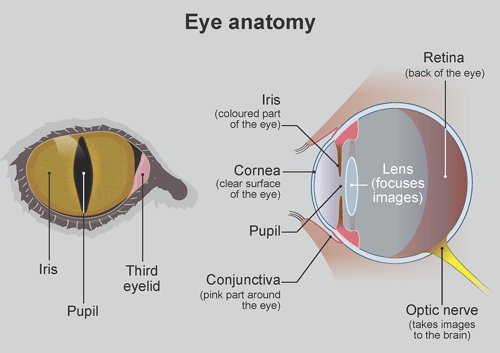
Your cat has conjunctivitis when one or more of these membranes get inflamed. Bacteria, viruses, or fungi can cause this cat eye infection. Feline herpes viral conjunctivitis, a viral disease, is one of the cats' most common causes of pink eye. It’s important to note that in very minor cases, pink eye in cats can resolve on its own. However, if your cat is in pain, showing signs of discomfort, or the condition worsens, it’s time to bring your kitty to the vet.
Common symptoms of feline conjunctivitis include:
- Redness of the eye or surrounding skin
- Watery, cloudy, dark, yellow, or green discharge from the affected eye(s)
- Squinting or excessive blinking
- Noticeable swelling of the eyelid or conjunctiva
Cats suffering from conjunctivitis may also show symptoms of an upper respiratory infection, like sneezing, a runny nose, lethargy, or a decreased appetite.
2. Blepharitis
Another cat eyelid infection that is quite common in cats is called blepharitis. This condition exhibits similar symptoms to conjunctivitis, including itchy, red, and swollen eyelids. It’s named blepharitis because the affected cat may squint or blink quickly, known as blepharospasm in the veterinary world. Just like with cat pink eye, a cat with blepharitis often scratches and rubs at its face or eyes, leading to secondary damage to the surrounding tissues. In more severe cases, blepharitis can spread and include conjunctivitis and keratitis, which is inflammation of the cornea.
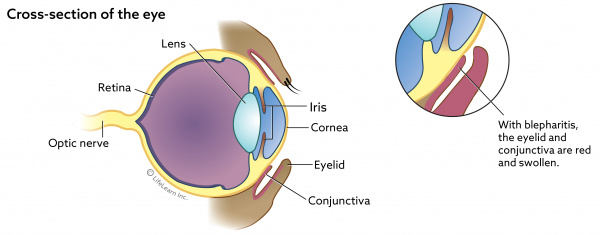
Common symptoms of blepharitis cat eyelid infection include:
- Dry, crusty material on the surface of the eyelids and/or small pimples
- Swollen glands along the margin of the eyelid
- Red, swollen, and itchy eyelid
- Cat blinking quickly
- Discharge that is clear, mucoid, or purulent (containing pus)
3. Keratitis (Inflammation of the Cornea)
Keratitis is a cat eye infection where the cornea (the surface layer of the eye) becomes inflamed. The cornea is usually transparent, but keratitis can cause the layer to become cloudy, which affects your cat’s vision.
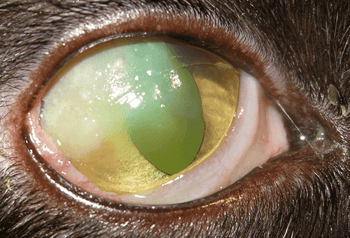
Sometimes keratitis is seen alongside conjunctivitis and blepharitis—the different cat eye infections can quickly develop into each other if left untreated. This is why sometimes you might see terms like herpes or viral keratitis. The types of keratitis listed below refer to how the infection affects your cat’s eye structures.
There are three main types of keratitis:
- Ulcerative keratitis (the deepest layers of the cat’s cornea are damaged or destroyed)
- Non-ulcerative keratitis (any inflammation of the cornea that doesn’t contain ulcers—which is diagnosed by use of fluorescein stain, a special dye used by vets that, if it doesn’t get retained in the eye, shows that an ulcer isn’t present)
- Eosinophilic keratitis (white, cottage cheese-like lesions on the cornea and/or conjunctiva)
4. Corneal Sequestrum
This condition can be caused by two different factors: as a secondary result of a cat eye infection caused by feline herpesvirus (FHV-1), or by brachycephalic (shortened head) breed disposition (Persian cats are especially susceptible). With corneal sequestrum, a piece of the cornea dies, causing a brown or black spot to develop on your cat’s eye.
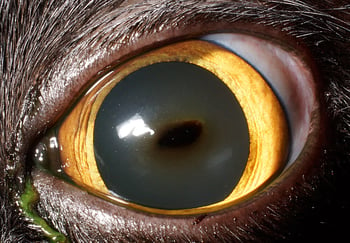
Many cats' tears will also become darkened and may crust on the eyelids. Sometimes, corneal sequestrum can result from an injury, or abnormalities of the eyelids, like when the eyelids turn inward. However, it can also develop with seemingly no cause at all. This condition may be painful for your cat and sometimes require surgery to remove the affected tissue. In some severe cases, your cat’s eye may need to be removed.
Signs that your cat may have corneal sequestrum (aside from the physical indication):
- Blinking and squinting
- Showing signs of light shyness (turning away or squinting when exposed to light)
- Weeping eyes
5. Keratoconjunctivitis Sicca (KCS)
Otherwise known as “dry eye”, this condition is caused by a virus affecting the tear-producing glands in your cat’s eyes. Moisture is necessary to keep your cat’s eyes lubricated and to remove any debris or infectious material that may come in contact with your cat’s eye. Tears are a mixture of mucus, fatty liquid, and water. Without adequate lubrication, your cat’s eyes will become red, inflamed, and painful. This condition can result in a secondary cat eye infection from feline herpes virus, immune-related diseases, some medications, and potentially inner-ear disorders.
Signs that your cat might have dry eye include:
- Wanting to hold their eyes shut
- Blinking excessively or squinting
- The eyes have a dull appearance due to corneal drying
Can You Get an Eye Infection From a Cat?
Some sources say that the bacteria causing a cat eye infection for your feline friend can potentially spread to you, causing eye problems. In one case, a woman went blind in one of her eyes because her cat licked her eye. This was due to the bacteria Bartonella henselae, which can cause a rare condition called “cat scratch” disease in humans. Typically, this disease is transmitted through bites or scratches (hence the name) but can also be transmitted through behaviours like licking.
The other cat-human disease that people often talk about, toxoplasmosis, can be transmitted from cats and affect your eyes. It’s most commonly transmitted through your cat’s feces. However, it’s extremely rare that someone can contract toxoplasmosis from a cat. You’re more likely to get it from contaminated meat or drinking unpasteurized goat’s milk than from your fluffy feline.
If you or someone in your household may become pregnant or is a transplant recipient, then that person should avoid cleaning the litter box.
Can Your Pet Catch An Eye Infection from an Affected Cat?
Depending on the underlying cause of the cat eye infection, it can be spread from one animal to another. The infection can spread to other animals if it is bacterial or viral.
If you have multiple pets in your household and you suspect your cat has an eye infection, it’s best to separate them from your other pets until you can bring them to your vet for a checkup. At that point, your vet can inform you whether the cat eye infection is contagious and advise whether you must keep your cat isolated from your other pets.
Cat Eye Infection Symptoms
A cat eye infection can be a severe cat health issue. You’ve probably connected the dots already and noticed that all the different types of cat eye infections could have similar symptoms and, if left untreated, can lead to more serious eye infections that affect more structures within your cat’s eye.
It’s harder to identify symptoms of a cat eye infection because a symptom is a “subjective experience”. Because your kitty can’t tell you about the symptoms they feel, you can look for obvious, physical signs of eye infection in cats, but other signs, like behavioural changes, might not be as evident unless you’re looking for them.
Eye Infection in Cats: Physical and Behavioural Signs
| Physical |
Behavioural |
|
|
What Causes Cat Eye Infection?
If your kitty is suffering from a cat eye infection, you’re likely wondering what in the world could have caused it. It can be tough to put your eye on the actual cause, but here are some common cat eye infection causes you can consider.
1. Feline Herpes virus (FHV-1)
The feline herpes virus is a common potential cause of cat eye infection. One small study of 42 cats showed that 43% had FHV-1, while another study of 78 cats found that 63% had FHV-1. Other sources state that up to 90% of cats have FHV but don’t provide any real evidence. However, it’s a relatively common disease because it’s very contagious among cats.
The cat eye infection types that we discussed earlier can all be caused by, either directly or indirectly, by FHV-1.
This is because the disease affects the main areas in your cat’s body are the respiratory system and the eyes. Symptoms can range from mild to severe, but unfortunately, the disease is not curable. Instead, symptoms can be treated, and the disease can go dormant in your cat’s system. However, it can flare up again at any time.
2. Allergies
Another potential cause of eye infection in cats is allergies. Like humans, cats can be allergic to fleas, pollen, household chemicals, smoke, shampoo, and more. Chances are, if your cat is getting inflamed eyes due to allergies, it’s probably coming in direct contact with their eyes—so start by eliminating a potential allergen one at a time, and see if things improve. Your vet can also perform an allergy test to help you identify the cause faster if symptoms are severe.
3. Trauma or Injury
If your cat gets a foreign object in their eye or accidentally scratches it during a particularly intense ear-scratching session, then the resulting injury could also develop into a cat eye infection. In either of these cases, you would need to bring your cat to a vet for treatment. This would likely be a topical ointment, eyedrops, or NSAIDs to help reduce swelling and relieve pain.
What To Do If Your Cat Has An Eye Infection?
The first thing you should do if you suspect your cat has an eye infection is to take them to the vet. After your vet examines your cat and determines that a cat eye infection is the cause of their issues, they’ll recommend a course of treatment.
Is a Cat Eye Infection an Emergency?
The answer is maybe. If your cat is in extreme pain, and the eye is bleeding or becoming worse in terms of weeping, swelling, or redness very quickly, then it’s likely that your cat needs emergency help. However, suppose your cat seems only mildly uncomfortable and is otherwise eating, drinking, using the litter box, and acting normally. In that case, you can simply take your cat to the vet as soon as possible. If you communicate the problem to your regular vet, they may be able to get you in for an appointment sooner based on need.
It’s important to remember that an infection in cat's eye can spread to other areas of your cat’s body, potentially causing secondary issues that may result in serious conditions. In other words, infections are no joke and should be taken seriously, so you shouldn’t delay in taking your cat to the vet. That said, however, emergency veterinary care can be extremely expensive, so you should use your best judgement to determine whether your cat can wait for an appointment with your regular vet or if they need emergency care immediately.
Treating a Cat With Eye Infection
There are a variety of ways to treat a cat eye infection. The most common treatments are outlined in the table below:
| Cat Eye Infection Treatment Types |
Description |
| Topical eye medication |
|
| Oral medications |
|
| NSAIDs (Non-Steroidal Anti-Inflammatory Drugs) |
|
It’s important to remember never to give your cat a human triple antibiotic, such as Neosporin. These types of antibiotics can potentially cause severe, life-threatening responses in cats, such as anaphylactic shock. Only use medication on your cat if your vet has approved it, and be sure to carefully follow any instructions they give you.
How to Clean Cats Eyes Infection
Take a clean, soft cloth and dampen it with some clean water. Use the cloth to gently remove any discharge or crusty bits from your cat’s eyes. Doing so will likely help your cat to feel a bit more comfortable.
Your vet will likely prescribe eye drops or topical ointment to clean and treat your cat’s eye infection. Giving your cat eye drops or ointment can be quite difficult, as cats tend to be unwilling participants, to say the least! But it is necessary to ensure that your cat’s eyes stay clean and get the proper medication to heal from the infection.
To give you cat eye drops, follow these steps:
- Giving medication to a cat is often a two-person job. Grab a friend, family member, or partner to help you if you can.
- Gently hold your cat with their behind against your body. This position is ideal so that you can see what you are doing and use both of your hands to hold their head.
- Lift your cat’s chin so the affected eye is horizontal to the ground. This is important so that the eye drops don’t fall out!
- Using one hand, gently pull down your cat’s cheek to lower their eyelid
- If you have a helper, get them to administer the drops into your cat's eye. Ensure they do it slowly and without touching the applicator to the cat’s eye.
Administering ointment follows a similar process. Your vet will likely tell you to squeeze out a small stripe of the medication directly on your cat’s eye. Holding your cat the same way as if you were administering eye drops, gently pull down on your cat’s cheek to lower the eyelid and expose the eye. Gently squeeze a small stripe of ointment across your cat’s eye without touching your cat’s eye with the applicator. Your cat will likely instinctively blink once you do this, which distributes the medication into their eye.
Recommended Eye Infection Cat Products
If your cat has chronic eye infections or has something like feline herpes virus that causes some eye discharge but no pain, you might seek out cat eye rinse or wash products. Medications that treat eye infection in cats are usually only available via vet prescription.
Eye cleaner or eye rinse products may not treat eye infection in cats, but they can help your cat to feel more comfortable as the infection heals.
Here are some recommendations:
Nutri-Vet Eye Rinse for Cats
This inexpensive eye rinse helps clear dried mucous, foreign material, pollen, and other irritants and allergens from your cat’s eyes. To administer, first wipe any excess material from your cat’s eye corners with a soft, damp cloth, then apply 2-3 drops in each eye.
$12.99 CDN. Price as of June 2023.
Earthbath Hypoallergenic Facial Wipes

These wipes are perfect for safely removing the crusty buildup or gooey discharge from your cat’s eyes due to infection. They are made with 100% human-grade ingredients, and are free from artificial colours, fragrances, or any sort of harmful material that could aggravate your cat’s condition. They are safe to use on kittens as well.
$9.99 CDN. Price as of June 2023.
Vet Worthy Tear Stain Cleaner

When your cat has an eye infection, it can leave nasty stains on their fur near their tear ducts. This can dry and become crusty and uncomfortable. This tear cleaner is gentle on your cat’s fur and skin, but the manufacturer cautions against getting it directly in your cat’s eyes; it should only be used to clean your cat’s fur.
$13.38 CDN. Pricing as of June 2023.
Summary
As cat lovers, we do everything we can to ensure that our cats are healthy. We can give them cat supplements, feed them high-quality food, and more, but they can still get sick sometimes.
It can be a scary experience when your cat has an eye infection. But thankfully, there are a variety of methods to treat cat eye infection symptoms effectively. Once you understand the underlying cause of the infection and the signs that come with it, you can seek care for your feline friend and get them back to normal as soon as possible, with the help of your veterinarian.
Given how active cats are, it’s no surprise that they can also experience joint issues. Cat joint pain and other ailments can be treated with joint supplements like the ones offered by Integricare. TRI-ACTA is a great preventative supplement and can be given to your cat on a daily basis. TRI-ACTA H.A. is formulated for cats that are experiencing joint pain or have in the past. Both products contain 100% natural ingredients with no fillers or additives.
TRI-ACTA H.A. for Pets
Our maximum strength formula is optimally designed to accelerate the formation of cartilage, minimize inflammation, expedite the healing process, and improve joint conditions.

Check out where to buy Integricare products today!
Newsletter Signup
Subscribe to our newsletter to receive the latest news and exclusive offers.
.jpg?height=2000&name=Cliick_Integricare-DISPLAY-REVISEDV2%20(1).jpg)
Proactive & Therapeutic Joint Supplements
When given daily, Integricare joint supplements recover bone and joint injuries faster and help prevent mobility injuries from happening in the first place.

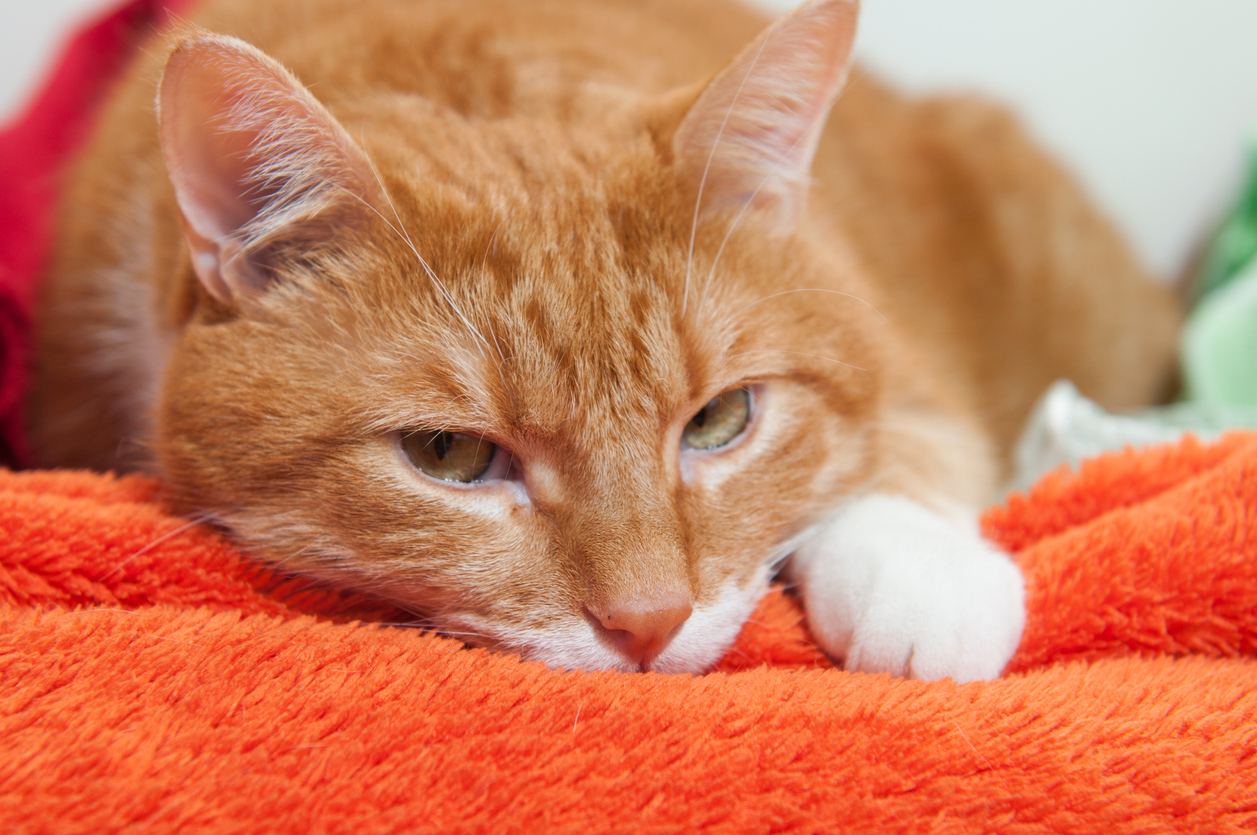






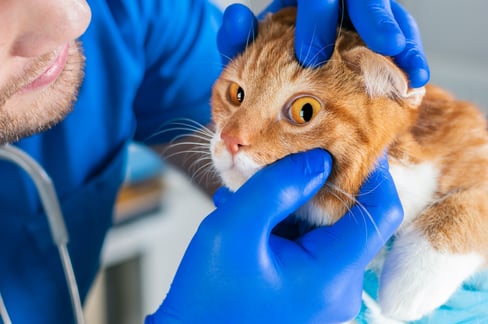

.jpg?width=488&height=325&name=dog-paw-infection%20(1).jpg)
